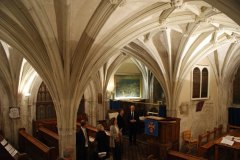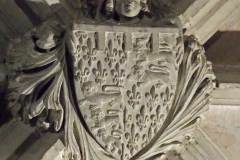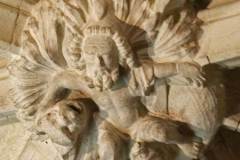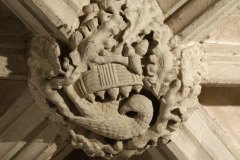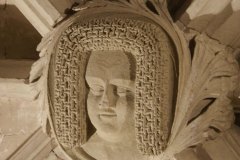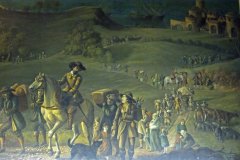Click here to see a plan of the cathedral with Viewpoint 23 marked.
Click here for an overview of the history and architecture of the crypt.
Click here to find the site of the Black Prince’s Chantry Stone, which records the site of the house the Chantry Priests occupied.
The south east transept of the cathedral crypt is today known as the Black Prince’s chantry or (since the 1880s) as the Huguenot chapel. Built originally in Romanesque style (like the rest of the present western crypt), it was founded as the Back Prince’s chantry in 1363 in thanksgiving for a papal dispensation that gave the Black Prince permission to marry his cousin Joan, known as the Fair Maid of Kent. The house of the chantry priests in Kings Street is still marked by one of Canterbury’s Cozens‘ paving stones. The chantry itself was refurbished in the decorated style of that day – redesigned central pillar, new vaulted roof with lierne vaulting and carved bosses, and new windows in the east and west walls. Two hundred years later, prosecution by catholic states in northern Europe drove growing numbers of continental protestants to England as refugees. Large numbers settled in Canterbury, where they were offered the western crypt for their worship. By the 1880s numbers had fallen (at one time one in five of Canterbury residents were of Walloon or Huguenot descent), and their worship moved to the Black Prince’s chantry. Services are still held here, in French, every Sunday at 3pm.
What to see (NB not open to the public other than for services or special arranged visits):
- a chapel still used for regular Huguenot worship in the French language (for overview see Image 1)
- many distinctive roof bosses – here (Image 2) a 14th century royal heraldic shield (Edward III), possibly the earliest royal arms in stone
- a good example of a ‘Green man’, sometimes called foliate heads (Image 3)
- one of several cathedral images of the ‘pelican in her piety’ (Image 4) – the medieval sculptor saw parallels with Christ in that the mother pelican seemed to be plucking blood from her breast to give sustenance to her young – modern science tells us she is in fact regurgitating food to pass on
- the elaborate hair style of Joan, Fair Maid of Kent (Image 5)
- an interesting painting by J Johnson (1866) showing French protestants in 17th century costume ascending cliffs by Dover castle en route to Canterbury – based on a 17th century etching by Jan Luyken but apparently found in a Dover pub! (Image 6)
Sources: standard cathedral sources; also booklet (no author, no date) Eglise Protestante Française de Cantorbery; also note by Michael Peters in web site http://www.frenchchurchcanterbury.org.uk/black_prince_chantry.htm
DL

